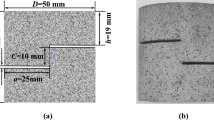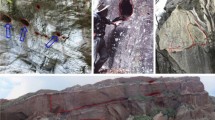Abstract
To study the deterioration of the mechanical properties of weathered granite and its damage characteristics under load, this paper carries out uniaxial compression and numerical simulation experimental research on fresh and weathered granite. The mechanical properties of fresh and weathered granite under uniaxial compression were analyzed, and the damage characteristics of weathered granite were revealed. Numerical models of different weathering degrees of the specimens were established based on FLAC3D, and at the same time, based on considering the distribution characteristics of granite microporosity, a random distribution model of weathered granite microporosity was established, and the deformation and damage laws of granite were obtained by numerical simulation. The results show that in the model considering the change of mechanical parameters of the rock in the weathering layer, the brittle tensile damage mainly occurs when the rock is not weathered. As weathering continues, the model undergoes brittle tensile and shear composite damage and gradually transitions to a damage pattern dominated by shear damage, which occurs when the rock strength deteriorates to about half of the fresh rock strength. In the model that jointly considers the mechanical parameters of rock microporosity and weathering layer, the microporosity affects the stress distribution to a certain extent, which leads to the change of the model strength and deformation damage characteristics. The damage form is closer to the real weathered rock damage, and the results of the study can provide a reference for the damage mode of weathered granite.













Similar content being viewed by others
Data availability
No data was used for the research described in the article.
References
Sakai Y, Kishi T. Numerical simulation of air permeability in covercrete assuming molecular flow in circular tubes. Constr Build Mater. 2016;125:784–9.
Ramadoss P, Li L, Fatima S, et al. Mechanical performance and numerical simulation of high-performance steel fiber reinforced concrete. J Build Eng. 2023;64: 105424.
Roussel N, Spangenberg J, Wallevik J, et al. Numerical simulations of concrete processing: From standard formative casting to additive manufacturing. Cem Concr Res. 2020;135: 106075.
Alberti MG, Enfedaque A, Gálvez JC, et al. Numerical modelling of the fracture of polyolefin fibre reinforced concrete by using a cohesive fracture approach[J]. Compos B Eng. 2017;111:200–10.
German M, Pamin J. Numerical simulation of non-uniformly distributed corrosion in reinforced concrete cross-section. Materials. 2021;14(14):3975.
Vieira D, Zerbe L, Belarbi A. Numerical modeling of iron-based SMA confined concrete columns under axial compressive loading. Eng Struct. 2023;275: 115185.
Beskopylny AN, Meskhi B, Stel’makh SA, et al. Numerical simulation of the bearing capacity of variotropic short concrete beams reinforced with polymer composite reinforcing bars. Polymers. 2022;14(15):3051.
Nikoomanesh MR, Goudarzi MA. Experimental and numerical evaluation of shear load capacity for sinusoidal corrugated web girders. Thin-Walled Structures. 2020;153: 106798.
Rossi P, Tailhan JL. Numerical modeling of the cracking behavior of a steel fiber-reinforced concrete beam on grade. Struct Concr. 2017;18(4):571–6.
Vo TD, Pouya A, Hemmati S, et al. Numerical modelling of desiccation cracking of clayey soil using a cohesive fracture method. Comput Geotech. 2017;85:15–27.
Jahangir MH, Sarrafha H, Kasaeian A. Numerical modeling of energy transfer in underground borehole heat exchanger within unsaturated soil. Appl Therm Eng. 2018;132:697–707.
Alizadeh R, Marji MF, Abdollahipour A, et al. Numerical simulation of fatigue crack propagation in heterogeneous geomaterials under varied loads using displacement discontinuity method. J Rock Mech Geotech Eng. 2023;15(3):702–16.
Wasantha PLP, Bing D, Yang SQ, et al. Numerical modelling of the crack-pore interaction and damage evolution behaviour of rocklike materials with pre-existing cracks and pores. Int J Damage Mech. 2021;30(5):720–38.
Zhao Y, Yang T, Zhang P, et al. The analysis of rock damage process based on the microseismic monitoring and numerical simulations. Tunn Undergr Space Technol. 2017;69:1–17.
Zhao K, Jia QY, Zhao K, et al. Numerical simulation of the effect of rock end effect on its acoustic emission. Mining Res Dev. 2008;1:13–5. https://doi.org/10.13827/j.cnki.kyyk.2008.01.007.
Zhao C, Niu J, Zhang Q, et al. Numerical simulations on cracking behavior of rock-like specimens with single flaws under conditions of uniaxial and biaxial compressions. J Mater Civ Eng. 2019;31(12):04019305.
Lin H, Cao P, Wang Y. Numerical simulation of a layered rock under triaxial compression. Int J Rock Mech Min Sci. 2013;60:12–8.
Lu H, Wang Y, Gan D, et al. Numerical investigation of the mechanical behavior of the backfill—rock composite structure under triaxial compression. Int J Miner Metall Mater. 2023;30(5):802–12.
Ma J, Jiang N, Wang X, et al. Numerical study of the strength and characteristics of sandstone samples with combined double hole and double fissure defects. Sustainability. 2021;13(13):7090.
Xu J, Fan Y, **ao X, et al. Experimental and numerical study of step-path failure in jointed rocks. Theor Appl Fracture Mech. 2023;126:103981.
Huang YH, Yang SQ, Zhao J. Three-dimensional numerical simulation on triaxial failure mechanical behavior of rock-like specimen containing two unparallel fissures. Rock Mech Rock Eng. 2016;49:4711–29.
Feng Q, Hou S, Liu W, et al. Study on the simulation method and mesoscopic characteristics of rock freeze-thaw damage. Comput Geotech. 2023;153: 105038.
Feng Q, ** J, Zhang S, et al. Study on a damage model and uniaxial compression simulation method of frozen–thawed rock. Rock Mech Rock Eng. 2022;55:1–25.
Li X, Wang S, Malekian R, et al. Numerical simulation of rock breakage modes under confining pressures in deep mining: an experimental investigation. IEEE Access. 2016;4:5710–20.
Wang M, Lu Z, Zhao Y, et al. Peak strength, coalescence and failure processes of rock-like materials containing preexisting joints and circular holes under uniaxial compression: experimental and numerical study. Theoret Appl Fract Mech. 2023;125: 103898.
Hu Z, **e L, Qin Y, et al. Numerical simulation of size effect of defective rock under compression condition. Sci Rep. 2023;13(1):420.
Baranowski P, Mazurkiewicz Ł, Małachowski J, et al. Experimental testing and numerical simulations of blast-induced fracture of dolomite rock. Meccanica. 2020;55:2337–52.
Saksala T. Numerical modelling of thermal weakening of granite under dynamic loading. Int J Rock Mech Min Sci. 2023;170: 105523.
Kalogeropoulos AD, Michalakopoulos TN. A method for selecting optimum microparameters’ values in the numerical simulation of rock cutting. Mining Metallurgy Exploration. 2023;40(1):211–27.
Saksala T, Jabareen M. Numerical modeling of rock failure under dynamic loading with polygonal elements. Int J Numer Anal Meth Geomech. 2019;43(12):2056–74.
Chemenda AI, Hassani R, Fan J. Numerical modeling of the opening mode fracturing emanating from deformation localization in layered rocks. Comput Geotech. 2022;147: 104774.
Pressacco M, Kangas JJJ, Saksala T. Numerical modelling of microwave heating assisted rock fracture. Rock Mech Rock Eng. 2022;203:1–23.
Turichshev A, Hadjigeorgiou J. Experimental and numerical investigations into the strength of intact veined rock. Rock Mech Rock Eng. 2015;48:1897–912.
Xu Y, Dai F, Du H. Experimental and numerical studies on compression-shear behaviors of brittle rocks subjected to combined static-dynamic loading. Int J Mech Sci. 2020;175: 105520.
**a Z, Jiang N, Yang H, et al. Effect of multiple hole distribution and shape based on particle flow on rocklike failure characteristics and mechanical behavior. Adv Civil Eng. 2020;2020:1–13.
Zhao B, Zhu G, Shang Y, et al. Predicting collapse depth of paleocaves in carbonate reservoirs. Carbonates Evaporites. 2021;36(2):27.
Lavrikov SV, Revuzhenko AF. Numerical modeling of elastic energy accumulation and release in structurally heterogeneous geomaterials. J Min Sci. 2016;52:632–7.
Huang Q, Zhao K, Yan Y, et al. Failure study of weathered granite based on critical slowing down theory and acoustic emission b-value. Archiv Civil Mech Eng. 2023;23(3):196.
Liu C, He M. Study on the changing law of mechanical properties of stone components within weathering layer. J Eng Geol. 2007;02:222–7.
Liu H. Macro mesoscopic defect effect on rock mass mechanics characteristic and the slope stability study. Rock Soil Mech. 2019;40(S1):431–9+448. https://doi.org/10.16285/j.rsm.2018.0458.
Acknowledgements
The study has been supported by the National Natural Science Foundation of China (Grant No. 52374138, 51764013), Leading Talents Program of Jiangxi Province’s Major Academic and Technical Leaders Training Program (Grant No. 20204BCJ22005), Key Projects of Jiangxi Natural Science Youth Fund (Grant No. 20192ACBL21014).
Author information
Authors and Affiliations
Corresponding author
Ethics declarations
Conflict of interest
No conflict of interest exits in the submission of this manuscript, and manuscript is approved by all authors for publication. I would like to declare on behalf of my co-authors that the work described was original research that has not been published previously, and not under consideration for publication elsewhere, in whole or in part. All the authors listed have approved the manuscript that is enclosed.
Additional information
Publisher's Note
Springer Nature remains neutral with regard to jurisdictional claims in published maps and institutional affiliations.
Rights and permissions
Springer Nature or its licensor (e.g. a society or other partner) holds exclusive rights to this article under a publishing agreement with the author(s) or other rightsholder(s); author self-archiving of the accepted manuscript version of this article is solely governed by the terms of such publishing agreement and applicable law.
About this article
Cite this article
Zhao, K., Liu, Y., Ma, C. et al. Numerical simulation of weathered granite considering microporosity and mechanical parameter variations. Archiv.Civ.Mech.Eng 24, 119 (2024). https://doi.org/10.1007/s43452-024-00936-3
Received:
Revised:
Accepted:
Published:
DOI: https://doi.org/10.1007/s43452-024-00936-3




